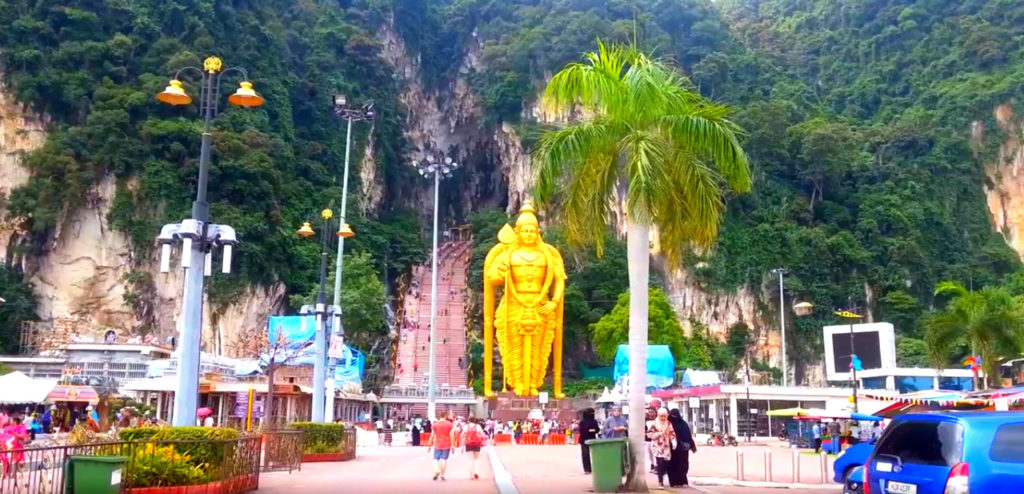Batu Caves is one of the most popular tourist attractions near Kuala Lumpur, the capital of Malaysia. It is a series of limestone caves and hills that houses a Hindu temple and several shrines.It is a place of great spiritual significance for the Hindu community. Every year thousands of tourists come there.

History of Batu Caves
Batu Caves is located in the Gombak area of Selangor District, Malaysia. These caves are thought to be about 400 million years old. This place became important to Hindus in the early 1800s.
It is said that a Chinese trader came to the region to collect fertilizing guano and discovered the first caves. The caves were unknown to the local people until 1860, K. Thambusamy Pillai discovered the caves and their religious significance.
K. Thambusamy Pillai was a devotee of the Hindu deity Lord Murugan, also known as Kartikeya, who thought of the caves as an ideal place to set up a Hindu temple dedicated to Lord Murugan.
Pillai’s dream was to build a temple dedicated to Lord Murugan at the entrance to the Batu Caves that would attract devotees from all over the world, construction on the temple began in the late 1800s and was completed in 1920, temple renovations and expansions are still ongoing, including the Lord Erecting the statue of Morgan which is the tallest statue of a Hindu deity in the world
Over the years, the Batu Caves have become one of the most popular Hindu shrines outside of India, attracting millions of visitors each year. The caves are particularly important to the Tamil community in Malaysia, who celebrate the annual Thaipusam festival at the site.
Attraction of Batu Caves
The main attraction of Batu Caves is its huge picturesque temple cave, which has to be climbed up a steep staircase of 272 steps. This temple honors Lord Murugan, the Hindu god of war, and is one of the most significant Hindu sanctuaries outside of India. Inside the cave, admirers can take in the elaborate carvings and sculptures as well as the stunning stalactites and stalagmites that adorn its walls and ceilings.
Together with its spiritual importance, it is a well-liked location for rock climbers from all over the world who come to scale its mighty cliffs. Climbers of various abilities can choose from a variety of routes in the caves and cliffs, from novice to expert.
If you’re planning a visit to Batu Caves, here’s what you need to know:
How to get to Batu Caves
Batu Caves is located about 13 kilometers north of Kuala Lumpur and is easily accessible by several modes of transportation:
Train: Using the KTM commuter train from KL Sentral station to Batu Caves station is the most straightforward way to travel to Batu Caves. The distance between the railway station and the cave entrance is only a short walk, and the train ride takes around 30 minutes.
Bus: Many bus lines, notably the Rapid KL bus route 11 and the Metrobus route 12, travel to Batu Caves from various locations in Kuala Lumpur. These buses are available from a number of places throughout the city, including Titiwangsa, Pudu Sentral, and KL Sentral.
Taxi or ride-hailing service: You can get to Batu Caves quickly and easily in Kuala Lumpur thanks to the abundance of taxis and ride-hailing services like Grab. If you’re going with a group or have a lot of luggage, this alternative may be more expensive than using public transit.
Car: From Kuala Lumpur, you can go to Batu Caves by taking the MRR2 highway. There is plenty of parking close to the entrance to the caves.
Overall, getting to Batu Caves is easy and convenient, with several transportation options available to suit your preferences and budget.
Batu Caves Entrance fees and opening hours:
Although there is no entrance fee for this location, there is a fee to enter some of the underground attractions, like the Dark Cave. The caves are accessible everyday from 6 am to 9 pm.
Dress code:
Batu Caves is a Hindu shrine, so visitors are expected to dress modestly. This means covering your shoulders and knees, and avoiding revealing clothing. It’s also customary to remove your shoes before entering the temple and other sacred areas.
What to expect: It is a series of limestone caves, with the largest and most impressive being the Cathedral Cave. The climb up the 272 steps to the Cathedral Cave can be tiring, but the views from the top are worth it. Inside the caves, you’ll find intricate Hindu shrines and sculptures, including the massive statue of Lord Murugan.
Thaipusam festival:
The Thaipusam celebration, which takes place in January or February and draws tens of thousands of devotees from all over the world, is one of the most well-known festivities hosted in Batu Caves. Participants in this event carry intricate structures called kavadis and engage in other devotional activities including body piercings with hooks and skewers as a form of penance and a display of their love for Lord Murugan.
Safety:
Batu Caves is generally a safe place to visit, but be aware of pickpockets and keep an eye on your belongings. If you’re climbing the stairs to the Cathedral Cave, take your time and watch your step, as the stairs can be slippery.
Other attractions near Batu Caves
There are several other attractions near Batu Caves, including the Dark Cave, a conservation center where you can learn about the ecology and geology of the caves, and the Ramayana Cave, which depicts scenes from the Indian epic.
Dark Cave:
Located within the Batu Caves complex, the Dark Cave is a conservation center where you can learn about the ecology and geology of the caves. The tour takes you through the limestone chambers of the cave, where you’ll see unique cave creatures and formations.
Ramayana Cave:
Also located within the Batu Caves complex, the Ramayana Cave is a Hindu-themed cave that depicts scenes from the Indian epic, Ramayana. The cave is filled with colorful statues and dioramas that tell the story of the epic.
KL Forest Eco Park:
Located about 5 kilometers from Batu Caves, the KL Forest Eco Park is a 200-hectare forest reserve that’s home to a wide variety of flora and fauna. The park has several walking trails and a canopy walkway that offers stunning views of the city skyline.
Royal Selangor Visitor Centre:
The Royal Selangor Visitor Center is a museum and studio dedicated to the craft of pewter manufacturing, and it is situated around 10 kilometers from Batu Caves. Anyone interested in learning more about the pewter-making process and its history can join a guided tour of the workshop.
National Zoo of Malaysia:
Around 5,000 animals from 476 species can be seen at the National Zoo of Malaysia, which is about 14 kilometers from Batu Caves. Visitors have the chance to spend time with a range of animals, including as elephants, tigers, and orangutans, as well as take part in feedings and animal performances.
In general, Batu Caves is a remarkable location that gives tourists the chance to discover the natural beauty of the caves and take in Malaysia’s rich cultural legacy. It serves as a recognizable representation of Malaysia‘s rich religious and cultural landscape.
In addition to marveling at the exquisite Hindu sculptures and learning about the region’s unique history and culture, tourists may take in breath-taking vistas of the city skyline. There are special possibilities to investigate the ecology and geology of the caverns in The Dark Cave and Ramayana Cave.
Anybody visiting Kuala Lumpur should make sure to stop here. It is a special opportunity that shouldn’t be passed up. Respecting the site’s cultural and religious significance and dressing appropriately are advised for visitors.
Whether you are a nature lover, adventurer, or culture enthusiast, It has something for everyone. It is a cultural gem that showcases the best of Malaysia and should be on every traveler’s bucket list.




